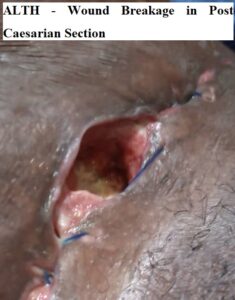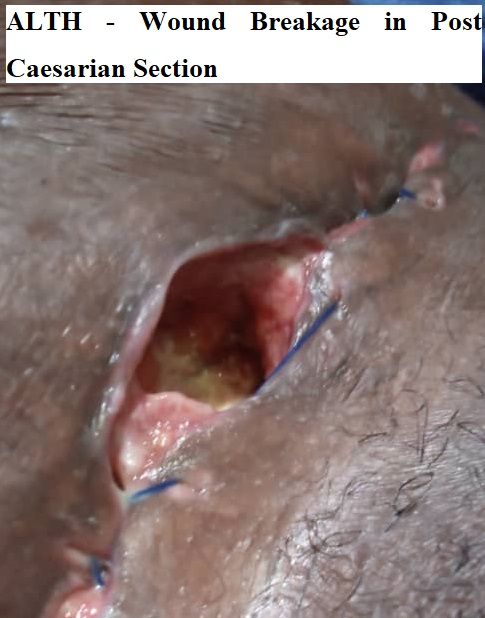Some women develop an infection at the site of the incision on the outer skin layers, instead of in the uterus. This is often called post-cesarean wound infection. Infections of the wound are often associated with fever and abdominal pain. These infections can also cause abscesses that fill with pus. If an abscess exists, the wound may have to be re-opened to drain and clean the infected area.
Wound breakage can be so devastating and life-threatening is poorly handled. There are many factors that can cause it but chiefly of all the factors is the infestation of bacteria (Staphylococcus aureus) around the incision. This cause series of infection like the one in the picture above.
Associated risk factors for wound breakage as post caesarian infection
There are many risk factors that can increase a person’s chances of developing post-cesarean wound infections, such as:
- Having a hematoma condition
- Bacterial infections in the amniotic fluid, or chorioamnionitis
- Smoking or using tobacco during pregnancy
- Having a larger incision size
- Shortage of prenatal care
- Obesity
- Using Corticosteroids
- Diabetes or gestational diabetes or other immune system weakening disease
- Multiple pregnancies like twins
- Having used epidural
- Ruptured uterus before surgery
- Being previously transfused
- Prolong surgery and emergency surgery are part of the causes


Symptoms Wound Breakage in Post Caesarian Section
The symptoms of post-cesarean wound infections vary from mild discomfort to extreme pain depending on the type and severity of the infection and do occur after 4-7 days after discharge. Some of the most common symptoms of post-cesarean section wounds include:
- Fever
- Tenderness
- Redness
- Swelling along or near the incision site
- Pain
- Pus or other discharge
- Hardening of the skin
If any symptoms of post-cesarean wound infections occur, never thought of self-medication or any unapproved approach to after avoidable complication. You’re strongly advice to see us.
Prevention of Wound Breakage in Post Caesarian Section
A person should seek proper medical care before and after the delivery to reduce the risk of developing wound breakage and infections. The risk can be mitigated by:
- Managing risk factors such as diabetes, obesity, and tobacco use
- Efficient management of health conditions that affect immune system
- Seek proper medical care before and after the delivery to reduce the risk of complications, at ALTH, we are more concerned about your wellness.
- Use recommended antibiotics before the surgery, particularly if a person has risk factors for infections
- Remind your doctor to wash the abdomen with saline water to reduce infection and ensure you are shaved.
Other methods may include:
- Cleaning wounds and changing their dressings based on doctor’s directive
- Use your drugs per prescription, no room for presumptuousness
- Avoid wear body-fitted cloth or heavy clothes as this may add pressure to the wound area.
- Shun strenuous activities, including driving, until you are told by the doctor
- Avoiding placing anything in the vagina or having sex for a few weeks
- Avoiding lifting heavier object than a baby
- Avoid unnecessary exposure of the incision
- Never consider junks, sweetening foods or anything candy as food at least for the few months


When to see US at ALTH
Always talk with us about unusual symptoms, especially:
- Pus or drainage from the wound
- Fever over 100.4°F (38°C)
- Increased pain
- Spreading skin redness
- Skin hardness


Recent Comments